OVERVIEW
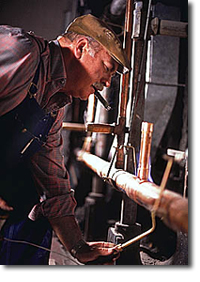 The road to be a licensed journeyman plumber in the construction industry is one of learning and understanding the general principles involved with the basic installations of all types of plumbing systems. Many books and code classes can give you the general knowledge needed to progress to this level, but only actual on the job training can prepare you for the tasks required to become a licensed journeyman plumber.
The road to be a licensed journeyman plumber in the construction industry is one of learning and understanding the general principles involved with the basic installations of all types of plumbing systems. Many books and code classes can give you the general knowledge needed to progress to this level, but only actual on the job training can prepare you for the tasks required to become a licensed journeyman plumber.
After becoming a licensed journeyman plumber the path one takes in the construction industry can vary greatly from one individual to another. An individual may decide that a journeyman plumber is all they want to achieve; others may want to progress to the level of a master plumber or several different other levels in the construction industry. These levels may include that of becoming a plumbing foreman (oversees several journeyman) while still performing work, or a plumbing superintendent (oversees several foreman) who plans and coordinates all aspects of a project. Another step would be that of becoming a project manager for plumbing projects. A project manager is usually the person who estimates projects, buys all the materials and plans and coordinates the projects with either his plumbing foreman or plumbing superintendent. The final step would be that of becoming the owner of your own plumbing company, over 1.6 million workers acted as subcontractors for property owners in 2000.
A career as a journeyman plumber is as broad as the imagination will allow one to see the future, and you are the future of our industry.
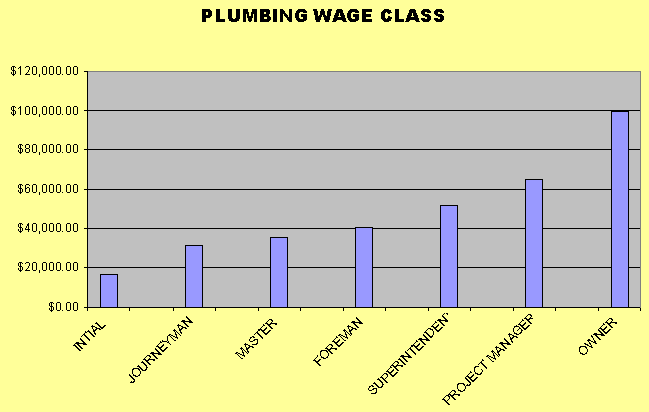
|
TRAINING/EXPERIENCE
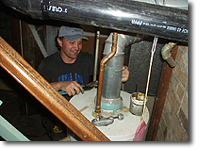 Most prospective plumbers begin their careers in the construction industry at the entry- level position of laborer or sometimes even a plumber's helper. This enables a person to see and experience first hand the actual installation and planning involved to properly install many different types of plumbing systems.
Most prospective plumbers begin their careers in the construction industry at the entry- level position of laborer or sometimes even a plumber's helper. This enables a person to see and experience first hand the actual installation and planning involved to properly install many different types of plumbing systems.
Once a person has decided that he/she may want to pursue the plumbing trade as a career, they will be entered into an apprenticeship program. An apprenticeship program is basically designed to pair a prospective plumber with a licensed master plumber who will instruct and guide the employee thru the progression to the next level, that of becoming a licensed journeyman plumber themselves.
While in the apprenticeship program, the employee will not only be getting on the job training, but also will be learning plumbing codes and general knowledge in the classroom. Sometimes, this classroom training is given by the company and other times it may be given at local technical or vocational schools. This apprenticeship program usually is a four (4) year minimum requirement before an individual may attempt to take the South Carolina journeyman plumbing exam.
LICENSE AND CERTIFICATION
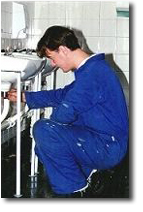
Journeyman Plumber - four years in the trade and requires documentation of two (2) years prior work experience under a licensed master plumber and successful passing of the South Carolina journeyman plumbing exam.
Master Plumber - four years in the trade and requires documentation of two (2) years as a licensed South Carolina journeyman plumber and successful passing of the South Carolina master plumbing exam. Requires 6 hours continuing education units to keep current.
Medical Gas Certification (not administered by State) - generally is a journeyman or master plumber cardholder. Requires 32-hour certification by a certified medical gas instructor. Has to be updated every 6 months with actual medical gas installation required.
JOB OUTLOOK
Job opportunities are expected to be excellent, as demand for skilled plumbers is expected to outpace the supply of workers trained in this craft. Many potential workers may prefer work that is less strenuous and has more comfortable working conditions.
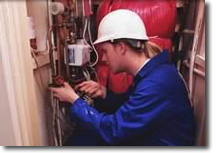 Employment of plumbers is expected to grow about as fast as the average for all occupations through the year 2012. Demand for plumbers will stem from building renovation, including the increasing installation of sprinkler systems; repair and maintenance of existing residential systems; and maintenance activities for places having extensive systems of pipes, such as power plants, water and wastewater treatment plants, pipelines, office buildings, and factories. The enforcement of laws pertaining to the certification requirements of workers on jobsites will create additional opportunities and demand for skilled workers. In addition to new positions resulting from employment growth, many jobs will become available each year because of the need to replace experienced workers who retire or leave the occupation for other reasons.
Traditionally, many organizations with extensive pipe systems have employed their own plumbers to maintain equipment and keep systems running smoothly. But, to reduce labor costs, many of these firms no longer employ a full-time, in-house plumber. Instead, when they need a plumber, they rely on workers provided under service contracts by plumbing contractors.
Employment of plumbers is expected to grow about as fast as the average for all occupations through the year 2012. Demand for plumbers will stem from building renovation, including the increasing installation of sprinkler systems; repair and maintenance of existing residential systems; and maintenance activities for places having extensive systems of pipes, such as power plants, water and wastewater treatment plants, pipelines, office buildings, and factories. The enforcement of laws pertaining to the certification requirements of workers on jobsites will create additional opportunities and demand for skilled workers. In addition to new positions resulting from employment growth, many jobs will become available each year because of the need to replace experienced workers who retire or leave the occupation for other reasons.
Traditionally, many organizations with extensive pipe systems have employed their own plumbers to maintain equipment and keep systems running smoothly. But, to reduce labor costs, many of these firms no longer employ a full-time, in-house plumber. Instead, when they need a plumber, they rely on workers provided under service contracts by plumbing contractors.
Because construction activity varies from area to area, job openings, as well as apprenticeship opportunities, fluctuate with local economic conditions. However, employment of plumbers generally is less sensitive to changes in economic conditions than is employment of some other construction trades. Even when construction activity declines, maintenance, rehabilitation, and replacement of existing piping systems provide many jobs for plumbers.

|
|
Source: Bureau of Labor Statistics, Office of Employment Projections; South Carolina Employment Security Commission
|
WAGES
Pipelayers, plumbers, pipefitters, and steamfitters are among the highest paid construction occupations. In 2002, median hourly earnings of pipelayers were $13.70. The middle 50 percent earned between $10.96 and $18.43. The lowest 10 percent earned less than $9.20, and the highest 10 percent earned more than $24.31. Also in 2002, median hourly earnings of plumbers, pipefitters, and steamfitters were $19.31. The middle 50 percent earned between $14.68 and $25.87. The lowest 10 percent earned less than $11.23, and the highest 10 percent earned more than $32.27. Median hourly earnings in the industries employing the largest numbers of plumbers, pipefitters, and steamfitters in 2002 are shown below.
| Nonresidential building construction |
$19.65 |
| Building equipment contractors |
19.52 |
| Utility system construction |
17.81 |
| Ship and boat building |
16.62 |
| Local government |
16.21 |
Apprentices usually begin at about 50 percent of the wage rate paid to experienced pipelayers, plumbers, pipefitters, and steamfitters. Wages increase periodically as skills improve. After an initial waiting period, apprentices receive the same benefits as experienced pipelayers, plumbers, pipefitters, and steamfitters.
Many pipelayers, plumbers, pipefitters, and steamfitters are members of the United Association of Journeymen and Apprentices of the Plumbing and Pipefitting Industry of the United States and Canada.
|
Source: Bureau of Labor Statistics, Occupational Employment Statistics Survey; South Carolina Employment Security Commission
|
BASIC SKILLS
Knowledge:
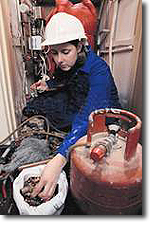
- Building and Construction - Knowledge of materials, methods, and the tools involved in the construction or repair of houses, buildings, or other structures such as highways and roads.
- Mechanical - Knowledge of machines and tools, including their designs, uses, repair, and maintenance.
- Engineering and Technology - Knowledge of the practical application of engineering science and technology. This includes applying principles, techniques, procedures, and equipment to the design and production of various goods and services.
- Design - Knowledge of design techniques, tools, and principles involved in production of precision technical plans, blueprints, drawings, and models.
- Mathematics - Knowledge of arithmetic, algebra, geometry, calculus, statistics, and their applications.
Skills:
- Installation - Installing equipment, machines, wiring, or programs to meet specifications.
- Equipment Selection - Determining the kind of tools and equipment needed to do a job.
- Operation and Control - Controlling operations of equipment or systems.
- Repairing - Repairing machines or systems using the needed tools.
- Coordination - Adjusting actions in relation to others' actions.
- Troubleshooting - Determining causes of operating errors and deciding what to do about it.
Abilities:
- Manual Dexterity - The ability to quickly move your hand, your hand together with your arm, or your two hands to grasp, manipulate, or assemble objects.
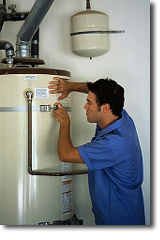
- Visualization - The ability to imagine how something will look after it is moved around or when its parts are moved or rearranged.
- Finger Dexterity - The ability to make precisely coordinated movements of the fingers of one or both hands to grasp, manipulate, or assemble very small objects.
- Multilimb Coordination - The ability to coordinate two or more limbs (for example, two arms, two legs, or one leg and one arm) while sitting, standing, or lying down. It does not involve performing the activities while the whole body is in motion.
- Arm-Hand Steadiness - The ability to keep your hand and arm steady while moving your arm or while holding your arm and hand in one position.
- Extent Flexibility - The ability to bend, stretch, twist, or reach with your body, arms, and/or legs.
- Information Ordering - The ability to arrange things or actions in a certain order or pattern according to a specific rule or set of rules (e.g., patterns of numbers, letters, words, pictures, mathematical operations).
Tasks:
- Assemble pipe sections, tubing and fittings, using couplings, clamps, screws, bolts, cement, plastic solvent, caulking, or soldering, brazing and welding equipment.
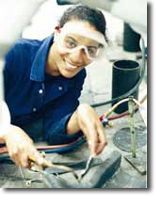
- Install pipe assemblies, fittings, valves, appliances such as dishwashers and water heaters, and fixtures such as sinks and toilets, using hand and power tools.
- Install underground storm, sanitary and water piping systems and extend piping to connect fixtures and plumbing to these systems.
- Locate and mark the position of pipe installations, connections, passage holes, and fixtures in structures, using measuring instruments such as rulers and levels.
- Measure, cut, thread, and bend pipe to required angle, using hand and power tools or machines such as pipe cutters, pipe-threading machines, and pipe-bending machines.
- Repair and maintain plumbing, replacing defective washers, replacing or mending broken pipes, and opening clogged drains.
- Study building plans and inspect structures to assess material and equipment needs, to establish the sequence of pipe installations, and to plan installation around obstructions such as electrical wiring.
|